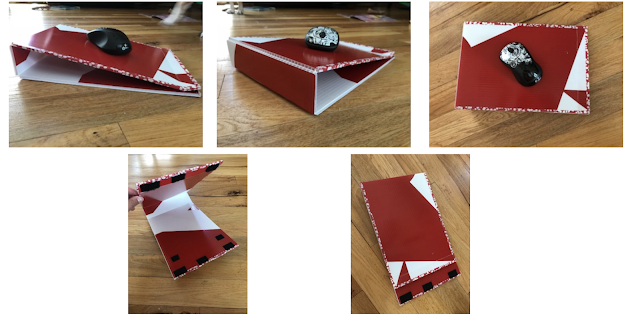Low Tech AT with Corrugated Plastic: Alternative Mouse Pad
By: Katelyn Baron, EC-SEAT Scholar
The solution I created is for an individual who experiences muscle strain in their forearm. They currently use a computer during their school day and at home for math/literacy enrichment. The regular mousepad was making their wrist turn towards the left and the position was uncomfortable and unnatural. This was causing more pain, than normal, in their forearm and in their wrist. I decided to make an ergonomic mouse pad to hopefully alleviate the strain and pain in the muscles in their forearm and wrist.
Materials and Tools
- Utility blade Coro Claw
- Ruler
- Corrugated plastic
- Velcro hook and loop
- Washi tape
- Grip Adhesive Non-Slip Pads
The pictures below show the mousepad is on an incline with the high side being 2 inches from the surface it is placed on. This incline allows for the wrist to be in a neutral position. The mousepad is also able to lie flat with the use of Velcro. The mousepad can easily fit into a their school bag without taking up a lot of space, so they can use it at home and school. Washi tape was used around the sides of the top of the mousepad to prevent the corrugated plastic from scratching the forearm or hand. The bottom has four grip adhesive non-slip pads to make sure that the mousepad doesn’t move around on the surface.
The individual has found great use of this new mousepad and has not experienced the strain and pain like she was, when using a regular mousepad. The family shared that the pad fits nicely in her bag and is easy to travel with. One improvement that the family suggested is to add another material on top of the corrugated plastic because her mouse sometimes slides down the incline. This could be resolved with a material that is smooth but also has more grip to it, possibly foam. She has only used this mousepad since it was given to her and the sliding of the mouse doesn’t cause her any pain it is just bothersome.
Another improvement that could be made to this design would be to add a wrist pad made of gel or another soft material for a place that the wrist could rest on. This would allow for a more comfortable place for the wrist and less pressure to be put on the wrist when using the mousepad. This also may allow for the arm to be more parallel with the ground/floor.
-->





Comments
Post a Comment
We invite you to share your thoughts and additional resources with our community of readers.
Also, contact us if you would like to be a guest blogger.